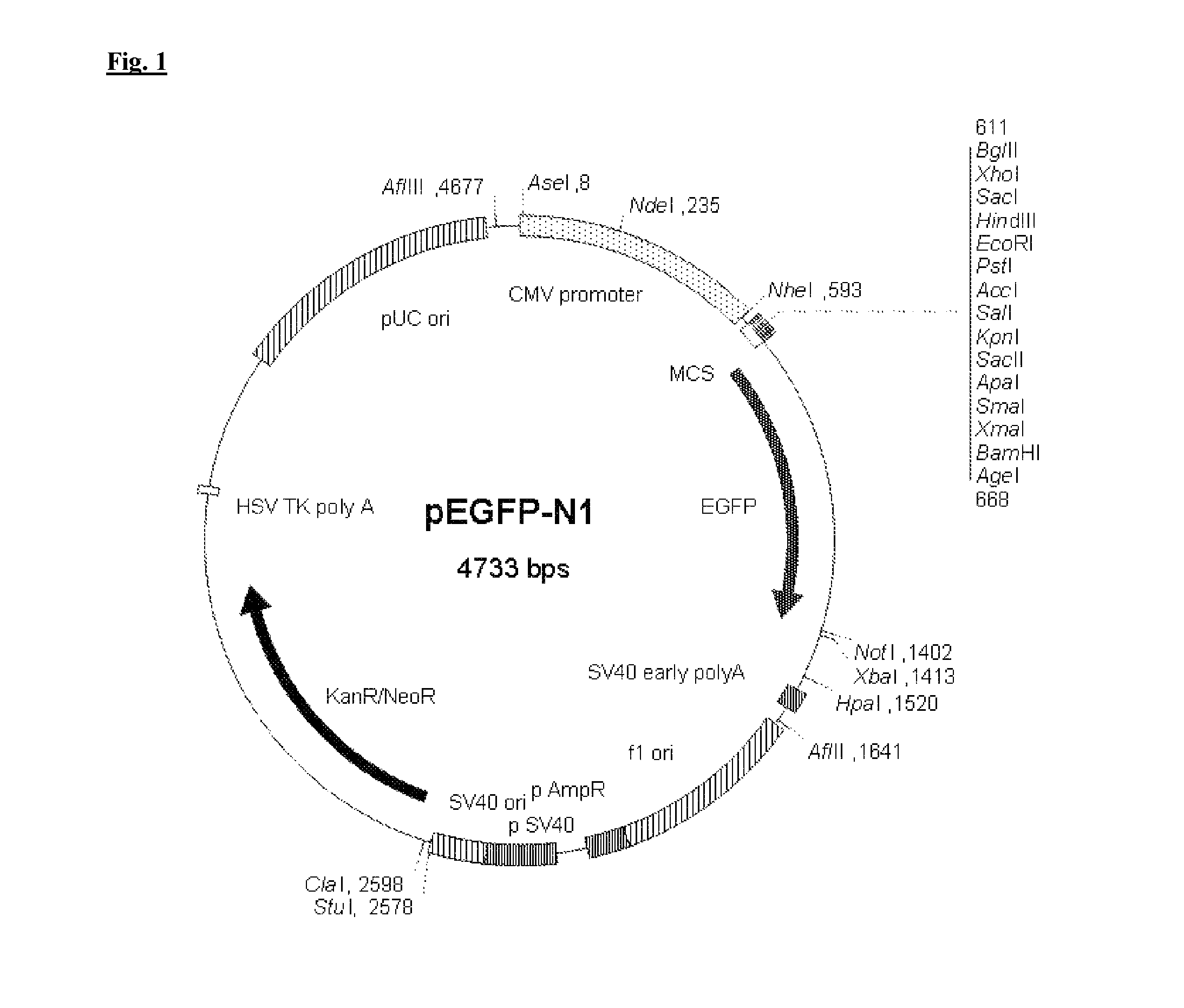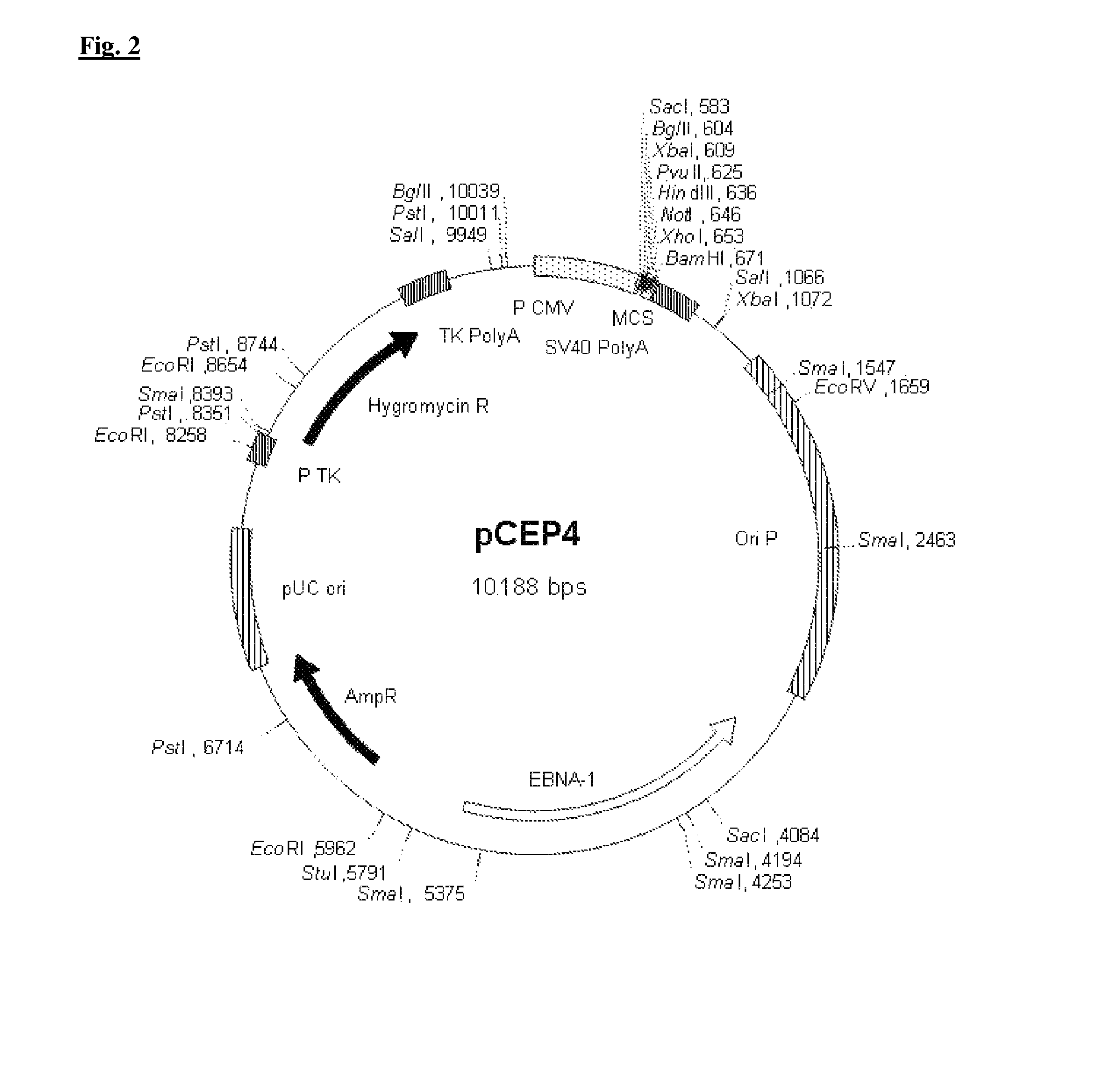Genotoxic testing
a technology of genotoxic testing and biosensors, applied in the direction of instruments, viruses/bacteriophages, artificial cell constructs, etc., can solve the problems of congenital defects in offspring, mutations in genes, and damage to gametes
- Summary
- Abstract
- Description
- Claims
- Application Information
AI Technical Summary
Benefits of technology
Problems solved by technology
Method used
Image
Examples
example 1
[0092]The following Example outlines the components that have been used in the construction of a series of GADD45α-EGFP Human cell culture DNA damage biosensors / reporters according to the first and second aspects of the invention. In addition, this Example describes the construction of the biosensors (cells according to the third aspect of the invention), and illustrates how they respond to a genotoxic agent, for example, methanesulphonic acid methyl ester (MMS) when utilised in a method according to the fourth aspect of the invention.
1.1 System Components:
(i) The Promoter—From GADD45α
[0093]The source of the GADD45α promotor is the plasmid pHG45-HC from Albert J. Fornace Jr., M.D. (National Cancer Institute, Building: 37, Room: 6144, National Institutes of Health, Bethesda, Md. 20892, USA), which is illustrated in FIG. 3.
(ii) The Fluorescent Protein—Clontech's EGFP
[0094]The source of the Green fluorescent protein is the Clontech plasmid pEGFP-N1 (BD Biosciences Clontech UK, 21 In Be...
example 2
[0129]Further experiments were conducted to evaluate the effects of autofluorescence caused by conventional media in order that preferred media may be developed for use in the method according to the fourth aspect of the invention.
[0130]The constructs, cells and protocols described in Example 1 were used unless indicated to the contrary.
[0131]As-well-as riboflavin (see 1.4) the inventors established that a second major contribution factor to cell culture media autofluorescence was phenol red (a pH indicator dye commonly used in culture media). The fluorescence of phenol red also varies with pH. Therefore it is preferred that media used according to the invention is formulated as a modified low autofluorescence medium whereby phenol red or riboflavin, but preferably both phenol red and riboflavin, is omitted (see table 1).
[0132]Referring to FIG. 12, the use of conventional RPMI 1640 medium decreased fluorescence signal to noise ratios, and increased variability of fluorescence measur...
example 3
[0135]Further development work was conducted to develop a most preferred protocol for conducting the method according to the fourth aspect of the invention in 96 well plates.
[0136]The constructs, cells and protocols described in Example 1 were used unless indicated to the contrary.
[0137]A preferred method of testing for DNA damage according to the fourth aspect of the invention comprises the steps of: (1) preparing a microplate for use in an assay; (2) conducting the assay in the microplates; (3) collecting and analysing the data; and (4) making a judgment on DNA damage and the consequences.
[0138]Details of steps (1)-(4) for conducting a most preferred test for DNA damage are given below.
3.1 Microplate Preparation.
[0139]Assays were carried out in 96 well, black, clear-bottomed microplates. For example Matrix ScreenMates, Cat. No. 4929, Apogent Discoveries, USA, or Corning (BV, Netherlands: Cat. No. 3651). A number of alternative microplates were assessed, though the variable backgro...
PUM
| Property | Measurement | Unit |
|---|---|---|
| wavelengths | aaaaa | aaaaa |
| wavelengths | aaaaa | aaaaa |
| concentration | aaaaa | aaaaa |
Abstract
Description
Claims
Application Information
 Login to View More
Login to View More - R&D
- Intellectual Property
- Life Sciences
- Materials
- Tech Scout
- Unparalleled Data Quality
- Higher Quality Content
- 60% Fewer Hallucinations
Browse by: Latest US Patents, China's latest patents, Technical Efficacy Thesaurus, Application Domain, Technology Topic, Popular Technical Reports.
© 2025 PatSnap. All rights reserved.Legal|Privacy policy|Modern Slavery Act Transparency Statement|Sitemap|About US| Contact US: help@patsnap.com



